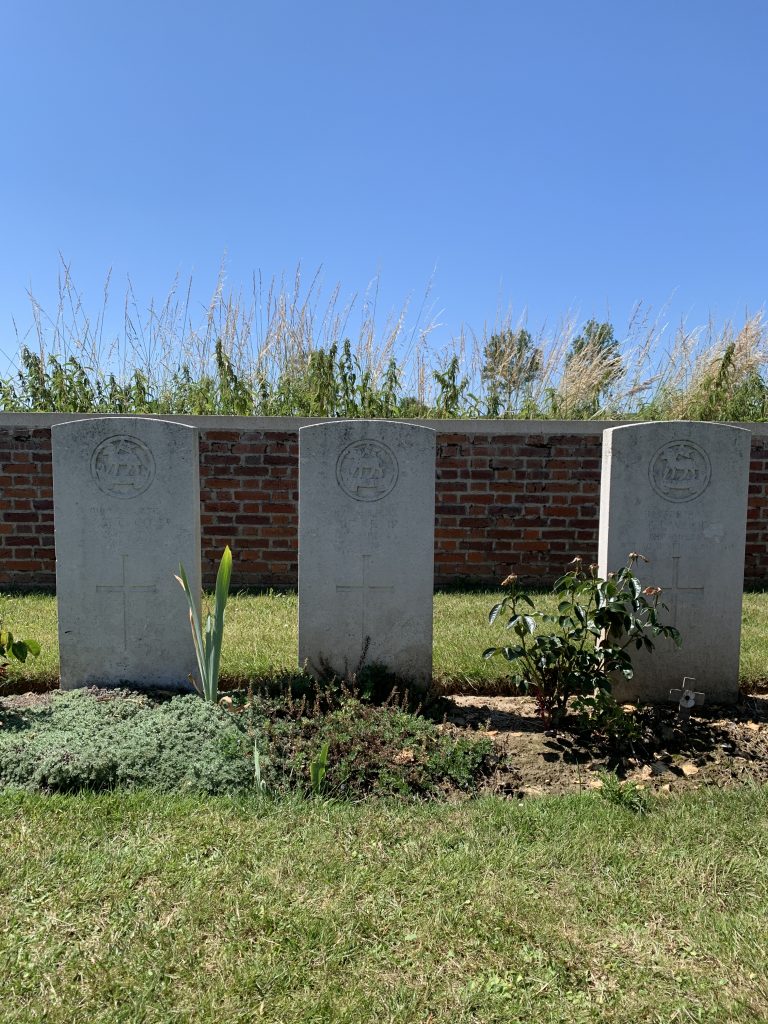At the close of August 1916, the officers and men of the 8th Battalion, the Queen’s (Royal West Surrey) Regiment were resting and regrouping outside Longueval, France. They had suffered considerable casualties during the previous week’s attack on the nearby village of Guillemont. While their time in reserve was meant to offer some respite, the area was still extremely active, and on 31 August the Battalion “was bombarded from 9.30 am till 4.30 pm, and from 9.30 pm – 1.30 [am] with gas shells” and experienced 19 additional casualties.
Five of those casualties are buried together at Dartmoor Cemetery in Becordel-Becourt, about ten kilometers southwest of Longueval. They lie in a row at the back of the small cemetery, which is well-manicured as all Commonwealth War Graves Commission sites are. However, in this cemetery the stones have become so weathered that it is difficult to make out the names of those commemorated here. Even the regimental insignia are faded, the Queen’s Paschal lambs worn and their banners nearly illegible.
We know little of three of the five buried here. For Private W.A. Inchcomb, Plot 40, and Private A.E. Shrove, Plot 42, we have only their dates of death and service numbers. Research attempts to learn more about these men have thus far proved unsuccessful. More information is available about Private Henry Barker, who rests between them at Plot 41. Barker was just 21 years old when he died and his parents resided in north London. How he, Inchcomb, and Shrove came to serve with the West Surrey regiment we do not know.
Sergeants T.J. Wood and Arthur Edmund Kemp rest side by side at Plots 38 and 39. They seem to have led parallel lives in many ways – both were 29 years old at their deaths and both hailed from Ramsgate, Kent. Their deaths were announced on 16 September 1916 in the Thanet Advertiser, a paper published not far from their shared hometown. The article noted that the two “did their training together, and both reached the rank of sergeant. They left England for the Western Front on August 31st, 1915, and were killed on the anniversary of their arrival at the scene of the fighting.”
The 8th Queen’s Regimental Quartermaster Sergeant George Kerswell was one of the battalion’s most prolific correspondents. He wrote to Arthur Kemp’s mother, Mary Jordan, following the loss of her son. Kerswell recalled speaking with both Kemp and Wood on 30 August, as the battalion moved from one reserve camp to another, slightly closer to the front lines. He wrote: “ I was in the march walking between Sergt. Kemp and Sergt. Wood, only a few hours before their deaths, and we discussed all the happenings of that eventful day. It was a great shock when I heard afterwards of our great loss…. Both Sergt. Kemp and Sergt. Wood were instantly killed and did not suffer.”
Kemp’s story is a particularly sad one. He was one of three brothers, and, according to his local paper, “almost the sole support of his mother.” Prior to the war he had worked as a furniture polisher and was later employed by funeral furnishers Messrs W. P. Blackburn and Sons. He had previously suffered the effects of a gas attack and spent time at a convalescent camp, but returned to the front before meeting his ultimate fate on 31 August near Longueval. Arthur, who was heartbreakingly known to his family by the nickname “Tiny,” was commemorated in the local paper on the anniversary of his death for the next several years. These remembrances were signed by “Mother and Rose,” possibly a sweetheart. Sadly, the Kemp family suffered further tragedies after Arthur’s death. His elder brother Frederick Thomas Kemp was killed in action while serving with the Somerset Light Infantry on 6 March 1917, aged 41 years old. Frederick would be mourned by his wife, Katie, and their three young children.
Almost certainly, the stories of the other four Queen’s men buried at Becordel-Becourt are equally as sad as that of Arthur Kemp. Doubtless, they each had people who loved them, hopes for the future, homes and careers to return to. While we do not know these details, we do know their lives were similarly cut short on that late August day in 1916. Though it is impossible to find sense in this tragedy, there is something poetic about the five men resting together in this back corner of a mostly-forgotten cemetery in rural France. If nothing else, at least they lie with their comrades.
Sources
“August 1916.” War Diary of the 8th (Service) Battalion Queen’s (Royal West) Surrey Regiment. First World War Diaries. Queen’s Royal West Surrey Regiment Website.
Letter, H.J.C. Peirs to H.V. Peirs. 31 August 1916. The First World War Letters of H.J.C. Peirs.
Letter, H.J.C. Peirs to Charlotte Peirs. 2 September 1916. The First World War Letters of H.J.C. Peirs.
“Comrades Till Death – Ramsgate Man’s Fate.” Thanet Advertiser, 16 September 1916. British Newspaper Archive.
“Brothers Killed. – Ramsgate Mother’s Double Bereavement.” Thanet Advertiser, 31 March 1917. British Newspaper Archive.
“Brothers Killed.” Thanet Advertiser, 7 April 1917. British Newspaper Archive.
“In Memoriam.” Thanet Advertiser, 25 August 1917. British Newspaper Archive.
“In Memoriam.” Thanet Advertiser, 31 August 1918. British Newspaper Archive.
“W.P. Blackburn & Son.” Thanet Advertiser, 15 December 1939. British Newspaper Archive.



